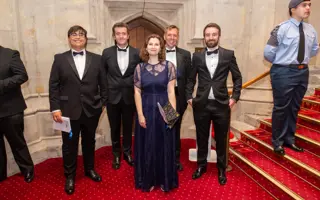
Role models for young children mean a fairer future for us all
Walk into most primary schools and ask a group of eight-year-olds to draw an engineer. Chances are, they’ll sketch a man in a hard hat. That’s not surprising – after all, what they’re seeing today is a profession still cloaked in outdated stereotypes.
It’s time we changed that, once and for all. We’ve been talking about it long enough.
What we need is a laser focus on the urgency for more engineering role models who are women to step into classrooms and ignite a spark in the next generation. Because the absence of relatable women engineers in the minds of our children isn’t just a missed opportunity; it’s a quiet tragedy with long-reaching consequences that are, quite frankly, terrifying for the future of society and the planet.
Catch them young with connection and representation
Children form beliefs early: about themselves, about the world, and about their place in it. By the age of seven, many have already decided what’s ‘for boys’ and what’s ‘for girls’. Engineering is still seen as a man’s world, so girls start to believe they don’t belong there. Boys may also form the unconscious bias that their female classmates don’t belong there either. The result – all genders are missing out on an inclusive engineering future.
But when a young girl meets an engineer who is a woman she can relate to, something extraordinary happens. That girl begins to imagine herself in the same role. Engineering becomes not an abstract discipline, but a human one. Her sense of belonging expands.
But this isn’t just about the girls. Boys need to see engineers who are women too. They need to grow up recognising that technical brilliance isn’t gendered, that leadership doesn’t look one way, and that collaboration is richer when different voices are at the table.

© Alex Knight / STEMAZING
The ripple effect
I founded STEMAZING to empower and equip women in STEM to be the visible role models our young people need to see and engage with. We run a unique online training programme that supports women to level-up as visible role models and deliver a series of interactive STEMAZINGKids sessions in primary schools. In the last five years we have trained over 600 role models and collectively led over 160,000 STEMAZINGKids engagements with children aged 7 to 9 years old.
Our aim is to ensure that every child gets hands-on with STEM experiments, feels that STEM is accessible for them, and sees that pursuing STEM can lead them to a career where they can make a difference doing something they love.
Research from Engineering UK shows that young people who engage in a STEM activity are 3.4 times more likely to consider a career in engineering, and girls who see women as role models are more likely to believe they can pursue this path themselves.
Research from Engineering UK shows that young people who engage in a STEM activity are 3.4 times more likely to consider a career in engineering, and girls who see women as role models are more likely to believe they can pursue this path themselves. This will ultimately lead to increased interest in STEM subjects, greater retention of diverse students through school and into higher and further education, and more equitable outcomes in future careers, but we have to catch them young first.
The benefits for role models
We know firsthand from all our work at STEMAZING, that for the women themselves, becoming a role model is not just an act of generosity – it’s an act of personal empowerment. It validates their journey, their presence, and their authority in a field where they may sometimes feel invisible. It builds confidence, strengthens leadership skills, and fosters a sense of purpose that extends beyond their day job.
There is also a profound emotional reward. Watching a young girl’s eyes light up with recognition – “She’s like me!” – is a moment of connection that stays with a person. These encounters can heal the wounds of isolation some women have experienced in their own careers. They create community across generations.
A fairer future for all of us depends on it
Let’s not forget what’s at stake for society. Engineering challenges in the 21st century – from climate change to infrastructure resilience to AI ethics – demand diverse minds. Solutions created by a narrow demographic risk blind spots and biases. A more inclusive engineering workforce isn’t just a social nice to have, it’s a technical and societal imperative.
And yet, despite the clear benefits, we continue to see a bottleneck of underrepresentation. This is where role models make all the difference.
The call to action: engineering businesses, step up
Only 16% of the engineering and technology roles in the UK are held by women. Clearly, this is not enough, and it’s not just the UK facing this problem.
However, instead of looking at the problem with a scarcity mindset, you can find ways to be the change you want to see. For example, support organisations that are actively already making a positive impact in this space and ensure women in your organisation feel seen and supported to be visible role models.
That meagre 16% still equates to nearly a million women working in engineering and technology in the UK today. We have about 20,000 primary schools, so that is 50 women as engineering role models for every primary school! That’s a number I am excited about, because it shows we already have enough role models to start the ripple effect we’ve been waiting for.
Businesses must actively encourage and invest in their people to engage with schools – not as a box-ticking exercise, but as a core part of professional development and corporate responsibility. Provide time. Offer training. Recognise the emotional labour involved and reward it. Celebrate those who do it well. And most importantly, value the visibility of your people as a strategic asset, not a soft extra.
Businesses must actively encourage and invest in their people to engage with schools – not as a box-ticking exercise, but as a core part of professional development and corporate responsibility.
If we want a future with inclusive engineering and technology that benefits everyone in society, we need more diverse engineers designing and building these solutions. This means we need more diverse role models in primary school classrooms today.
The question is no longer should women engineers step into the spotlight. It’s how can we help them get there right now? Let’s bring the future into the classroom – and let it look like all of us.
Get a free monthly dose of engineering innovation in your inbox
SubscribeOther content from Ingenia
Quick read

- Environment & sustainability
- Opinion
A young engineer’s perspective on the good, the bad and the ugly of COP27

- Environment & sustainability
- Issue 95
How do we pay for net zero technologies?
Quick read

- Transport
- Mechanical
- How I got here
Electrifying trains and STEMAZING outreach

- Civil & structural
- Environment & sustainability
- Issue 95